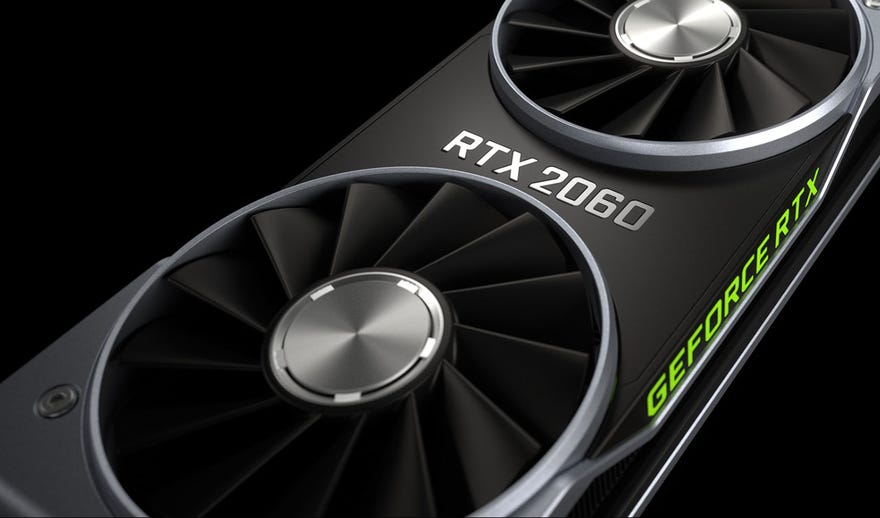What’s going on with Nvidia’s 12GB RTX 2060?
Oh hey, another graphics card you can’t buy
It’s been nearly a year since Nvidia started reissuing older GPUs, like the GeForce RTX 2060 and GeForce GTX 1050 Ti, to help deal with the great worldwide graphics card shortage. More recently, Nvidia went a step further, quietly launching a brand new version of the RTX 2060 that doubles its VRAM to 12GB.
Emphasis on the “quietly”, mind – even if you’ve been regularly checking for available GPU stock or perusing our graphics cards deals guide, you probably won’t have even noticed there’s a 12GB RTX 2060 knocking around. So what’s the deal with this mysterious card, and should you even consider buying an RTX 20 series card in this day and age?
It is, after all, still based on the old Turing architecture, so while you’d still get DLSS and basic ray tracing support, the 12GB RTX 2060 won’t deliver overall performance on par with Ampere GPUs like the RTX 3060. Then again, there is a certain logic to bringing back old GPUs: with production costs long recouped, they can (in theory) sell at lower prices than the RTX 30 series or AMD’s Radeon RX 6000 series. A potential tonic for the massive inflation that other models are suffering – maybe not one of the best graphics cards right now, but a capable bit of kit for most games.
Sadly, the 12GB RTX 2060 immediately has a different yet still familiar problem: there’s hardly any stock for it. After spending probably too much time looking, I have found precisely one UK listing that actually has a price, via Punch Technology. Scan has the same Zotac-made model, without a given price. Both are out of stock.
It’s tempting to blame this on the usual scalper bots and cryptocurrency miners, though it’s also unclear how many 12GB RTX 2060s have been produced in the first place. Again, Nvidia really, really hasn’t made a song and dance of the release, with its official UK site not even acknowledging the new spec exists.

But even if new stock was leaving the factory in droves, the 12GB RTX 2060 isn’t actually that cheap. Punch Technology’s asking price is £515, nearly twice what the original 6GB RTX 2060 cost at launch, while in the US it’s available (yay) for $772 (aww). The only positive thing I can think to say about this is that the original RTX 2060 is hardly in a better place, costing anywhere between the $700 to $1000 range, depending on how willing you are to import. The souped-up RTX 2060 Super, with its 8GB of VRAM, is even pricier, though back in the UK you can at least get a 6GB RTX 2060 for under £450.
It’s a situation that makes one wonder if the new model was ever really meant to be an affordable gaming GPU to begin with. Perhaps tellingly, the 12GB RTX 2060 doesn’t come with Nvidia’s usual hash rate limiter, which is commonly included on their newer GPUs to kneecap crypto mining effectiveness. My understanding is that the RTX 2060 was never an amazing mining card to begin with, though it does look likely that the 12GB version was designed to feed the crypto crowd as much as hard-up PC builders.
This doesn’t have to be a bad thing. If miners are buying mining cards, it means they’re buying fewer GPUs focused specifically on gaming, leaving more of the latter to go around. There’s clearly not much of a benefit, though, if there’s next to no stock to begin with.

It’s all quite the shame, especially since the 6GB RTX 2060 can still hold up reasonably well on performance. At 1080p, we’ve recorded it coasting past 60fps averages in Shadow of the Tomb Raider, Total War: Warhammer II, Monster Hunter: World and The Witcher III, all on their maximum graphics settings. Same for Assassin's Creed Odyssey on its Very High setting, while the RTX 2060 Super usually added around 10fps to each of these when Katharine tested it.
Like (apparently) most other tech hacks, I haven’t had any luck sourcing a 12GB RTX 2060 for review, though since it presumably wouldn’t perform any worse than these two other GPUs it should make a decent 1080p option as well. Alas, far from providing relief, this new version seems to have been immediately dragged down into the hellscape that is the contemporary PC graphics market. Welcome, and goodbye.


